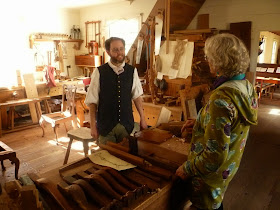 |
| Micky Callahan and Steven Lash Founded SAPFM |
Here is a short video which talks about SAPFM: Society of American Period Furniture Makers
However, after several years traveling to Williamsburg in January, which included a blizzard that closed the colonial village down for several days, I got to the point where spending January in San Diego seemed a better idea than looking for snow. That doesn't mean I lost interest in the activities of SAPFM. I follow them on the web, talk to other members often, joined the new Southern California Chapter when it was organized last year, and always look forward to the Journal.
 |
| Outdoor Seating In Williamsburg |
The Cartouche is a very significant award, but, here in Southern California, not many people understand what it means. I usually tell them it is like an Academy Award, since it is voted on by members of a group to recognize the achievements of another member of that same group. In other words it is an award of your peers, for lifetime achievement in a particular skill. You must be nominated and then a jury evaluates your efforts in various fields, like teaching, awards, creations, publications, lectures, etc. I am the first person West of the Mississippi to receive it.
Past winners have been craftsmen who made American period furniture, and all of these live on the East Coast. They include:
2013 Will Neptune
2012 Allan Breed
2011 Benjamin C. Hobbs
2010 Steven Lash
2009 Dennis Bork
2008 Alfred Sharp
2007 North Bennet Street School
2006 Fred Stanley
2005 Phil Lowe
2004 Mack Headley
2003 Gene Landon
2002 Robert Whitley
2001 John McAlister
2000 Harold Ionson
A few of these are no longer with us, but all of them are outstanding in their field, and I have been fortunate to have met all of them at one time or another. It is a great group of talent.
In looking at the winners and their work, I never considered for a moment that I might be eligible for such an honor. After all, I am an American who makes period furniture, but my furniture for the most part is European in style. All of the forms which I make date from 1680 to 1840 and are completely hand made. They are just not American. Generally, I prefer English, Dutch, German and French.
So it was a complete shock when I was contacted late last year and told that I had won the Cartouche and should return to Williamsburg to attend the Banquet. Wow!
Of course, watching the weather during January was discouraging. Something about an Arctic Vortex? All I could see on the news was "Freezing Cold!" "Dangerous Travel Conditions" "Stay Home!"
When I landed in Chicago for the transfer, it was 20 below zero and our flight out was cancelled. We were very fortunate to find another plane which was just departing, although we sat on the runway for over an hour while they figured out how to de ice the plane. Landing in Richmond, we got a car and made it to Williamsburg for the last 5 minutes of registration. Then to bed at the Lodge.
 |
| Period Furniture Demonstration |
I can remember hundreds of lectures I have given over the years, both to large and small audiences. I have never had the sensation of a packed room of perhaps 200 people rising as one and giving me a standing ovation. I don't have words to express how that felt. Holding the Cartouche Award and hearing the congratulations of the other furniture makers is indeed a special feeling. It was also personally significant, as I have never before made a Power Point presentation of all my work. With each new image, all I could think was, "I can't believe I made that!" That thought was quickly followed by "How did I do it?"
 |
| Frank Klausz Teaching 9 year old Boy about Dovetails |
The weather cleared up a bit on Sunday, and Kristen and I had a chance to wander around the village to see the homes, shops and take some tours. We stopped in at the cabinet shop to talk with Brian and Bill, the two young cabinetmakers who were presenters at the conference. They were putting their shop back together and getting back to work. Since there were few tourists at that time of year, we had a good chance to talk for several hours.
 |
| Kristen and Bill in the Cabinet Shop |
 |
| Roy Is Always So Serious! |
I left there with a nice boxwood plough. Like I need another plough. I can't help it.
 |
| TOOLS FOR SALE! |
We raced up the freeway to get back to Richmond before the roads became impossible. We were sitting in our nice hotel room watching the snow fall when we got the message that our plane had been cancelled the next morning. They were working to reschedule us later in the day.
We were the first plane out of Richmond after they cleared the snow off the runway.
 |
| Back At The Shop With Cartouche |











